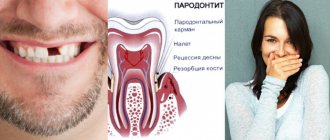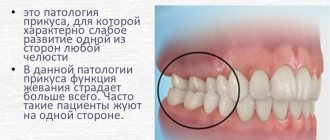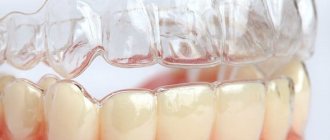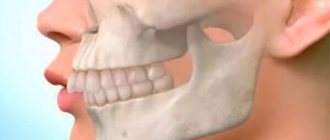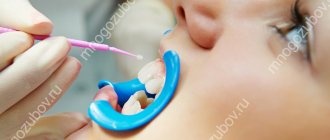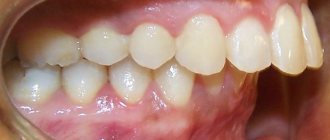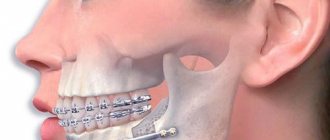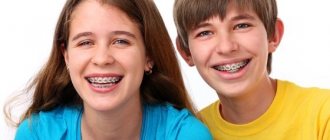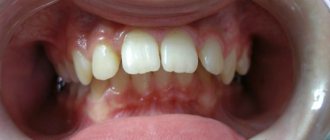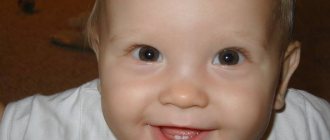Perhaps every person has come across such concepts as correct and incorrect bite. And if 20 - 30 years ago parents did not always attach importance to the fact that a child had crooked teeth, then modern mothers strive to cope with such a problem as early as possible.
Pathological occlusion is an anomaly in the development of the dental system. According to WHO, about 90% of children have problems to a greater or lesser extent. Do not be afraid of such high rates, since in modern orthodontics even a slight curvature or rotation of a tooth is considered a pathology.
Timely seeking dental help will eliminate the developing problem, because a broken bite not only makes the appearance less attractive, but also leads to more serious functional disorders.
Causes
Doctors have identified several prerequisites that lead to the formation of a pathological bite.
- Disturbance of intrauterine development, as a result of which individual teeth erupt incorrectly or changes occur in the temporomandibular joint.
- Violation of growth and development of bones of the facial skeleton.
- Genetic predisposition.
- Use of pacifiers and pacifiers after the age of six months or after the child's first teeth erupt.
- Birth injury.
- Early removal of baby teeth.
- Multiple caries lesions.
- Insufficient amount of calcium and fluorine in the developing body.
- Injuries to teeth and jaw bones.
- Unbalanced and poor nutrition.
The formation of a pathological bite can occur for one reason, or as a result of their combined influence. To prevent problems in the future, it is recommended to visit an orthodontist for a consultation no later than 3 to 4 years of age.
Possible causes of pathology
There are many factors that can influence the improper development of the dental system. But most of them parents are able to control and eliminate in time, if necessary, turning to doctors.
Possible reasons:
- errors when feeding in the first months (incorrect breastfeeding technique, incorrectly selected bottles, unsuccessful pacifier, etc.);
- using the pacifier for too long;
- errors when introducing complementary foods;
- regular stress on the jaws: the child constantly sucks his finger, bites a pencil, etc.;
- problems with nasal breathing;
- poor sleeping position;
- untimely destruction of baby teeth;
- bone diseases - rickets and others;
- heredity.
Let's take a closer look at the most common causes of malocclusion and how to correct them.
Who is at risk?
Particular attention should be paid to those children who have a history of the following predisposing factors:
- malocclusion, which occurs in adults and is passed on from generation to generation;
- impaired nasal breathing due to enlarged adenoids, allergic reactions or frequent colds;
- acquired systemic diseases (diabetes mellitus, pathology of the musculoskeletal system or nervous system);
- congenital poor posture;
- bad habits (sucking a finger or pacifier, biting nails or a pen, chewing food mainly with the front teeth, supporting the chin with your hand). (photo 3)
Options for correcting dental defects
We have looked at the main causes and signs of pathology, and now we will figure out what to do about the problem and how it is treated in dentistry. It should immediately be noted that in 40% of cases the anomaly is caused by skeletal disorders, and therefore requires an integrated approach to treatment. Let's look at the main methods for correcting prognathic occlusion in children and adult patients.
What treatment methods are used for children?
If a child exhibits the main signs of a distal bite, treatment should begin as early as possible - as soon as the bone is sufficiently formed for safe and effective correction with hardware techniques. The following describes the basic methods for eliminating the anomaly:
- For children 5-6 years old, prognathic occlusion is corrected without braces or surgery, using special bite formers and orthodontic plates. These methods make it possible to ensure further correct development of the dentofacial apparatus,
In early childhood, it is possible to correct the bite with the help of a plate - at 6-12 years old, for example, a Frenkel apparatus is used or special crowns with hooks are installed to fix elastic rods. Extraoral systems are also used that stop the growth of the jaw and literally pull it in the correct direction,
This is what the Frenkel apparatus looks like - At 13-14 years of age, braces are usually installed along with extraoral elastic traction, which promotes proper growth of the lower jaw.
One of the most effective treatment methods is braces.
In difficult cases, when the child reaches the age of 15, the problem has to be corrected surgically. In such situations, they usually remove the upper premolars and eights, if any, install braces and then wait until they are 23-24 years old to carry out a full-fledged orthodontic operation.
Is it possible to correct pathology in an adult?
When answering the question of how to correct pathology in adulthood, it is immediately worth noting that the treatment process will be more difficult and longer in time. Most often, orthodontic surgery is necessary to correct the size of the jaws. After treatment, myogymnastics is prescribed - special exercises for developing the facial and chewing muscles.
If the bite is not pronounced, then you can limit yourself to braces - straighten the teeth and slightly change the size of the jaw. But in general, there really is no way without surgery. During the operation, the position of the lower jaw will be slightly changed.
The photo shows a scheme for surgically correcting a bite
Types of malocclusion
Today in modern dentistry, doctors use several different classifications of types of malocclusion. Different systematizations may imply the same manifestation of pathology, but the disorders have different names. Let's look at the most common types of bite changes.
Distal bite
Its main feature is the posterior position of the lower jaw, which disrupts the key of occlusion, i.e. physiological closure of the sixth and third teeth, and the lower first molar has a more distal position compared to a similar tooth in the upper jaw, and the upper canine is located in front of the interdental space between the third and fourth tooth. In various sources you can find several variations of the name of this disorder: prognathia, prognathic occlusion, distoocclusion, posterior occlusion.
Clinically, the pathology manifests itself:
- convex face profile;
- shortened lower part of the facial skeleton;
- pronounced nasolabial folds;
- most often, in a relaxed position, the lips do not close;
- If the distal bite is too severe, the child may have problems with chewing, swallowing and breathing.
In addition, functional disturbances occur with distal occlusion. Due to the fact that the upper incisors protrude significantly forward, a sagittal gap is formed. This makes it difficult to bite and chew food. The predominance of mouth breathing leads to the fact that the shape of the lips changes, and the mucous membranes of the oral cavity dry out. Due to the fact that the lips do not close, this, in turn, leads to a change in the position of the tongue. Incorrect redistribution of pressure from the muscles of the cheeks and tongue leads to an even greater narrowing of the lower jaw, protrusion of the upper teeth forward and the length of the incisal overlap is aggravated.
Mesial bite
With this type of dental anomaly, the lower jaw protrudes significantly forward, while the upper canines are located behind the interdental space between the third and fourth teeth of the lower jaw. The clinical picture of mesial occlusion is as follows:
- concave profile;
- protruding chin;
- sinking of the upper lip;
- shortening of the lower part of the face;
- protrusion of the lower jaw forward.
Synonymous names for mesial occlusion are: mesioocclusion, progeny, progenic occlusion, class 3 according to Engle’s classification.
Deep bite
Deep overlap refers to violations of the relationship of the dental arches in the vertical plane. In this case, the child has a significant overlap of the lower incisors with the upper teeth (more than 2/3 of the height of the clinical crown).
To designate a deep bite, orthodontists use concepts such as a lowering or traumatic bite, as well as a deep incisal overlap.
A visual inspection reveals the following features:
- dentoalveolar shortening in the lateral jaw;
- dentoalveolar lengthening in the anterior jaw;
- atypical shape of the upper incisors, their excessively large size.
Clinical signs depend on what form of occlusion this pathology is combined with.
- Neutral bite – crowding of the upper front teeth, some flattening of the dental arch. The cutting edges of the lower incisors can damage the mucous membrane of the anterior part of the palate, and the incisors of the upper jaw can damage the interdental papillae and the outer side of the gums.
- Distal bite – the front teeth of the lower jaw rest against the palate and often injure it. Due to the fact that the upper incisors are excessively large, the lower jaw is blocked, i.e. conditions are created under which its growth becomes practically impossible.
- Mesial occlusion – there is a reverse incisal overjet when the lower teeth protrude forward and overlap the upper incisors.
The main reasons that lead to this relationship of the jaws are carious and non-carious lesions of the teeth in the lateral sections, due to which their abrasion occurs, a decrease in the height of the clinical crown and, as a result, a decrease in the bite. Early loss of primary teeth or first permanent molars also has an impact.
Open bite
Like a deep bite, this type of disorder refers to vertical anomalies in the position of the jaws. In this case, a gap is formed between the upper and lower front teeth, which does not disappear even when the premolars and molars are tightly closed. It can be either symmetrical or uneven. If an open bite is observed in the lateral part of the jaws, then the gap can be either one-sided or two-sided.
An open bite occurs either due to congenital disorders or due to the negative influence of bad habits. Therefore, if parents notice that the baby has begun to regularly suck his finger, chew a pencil or nails, then they need to try to wean him off as soon as possible.
An open jaw relationship can develop during different periods of bite formation. This means that this pathology occurs in children with milk and permanent teeth. Just like deep bite, open bite can be neutral, distal and mesial.
The severity of the anomaly is measured in the distance between the teeth of the upper and lower jaw:
- 1st degree – no more than 5 mm;
- 2nd degree – from 5 to 9 mm;
- Grade 3 – over 9 mm.
Crossbite
There are several definitions that characterize crossbite: oblique, vestibulocclusion, lingual occlusion and others. It often occurs during the period of intrauterine development, when disturbances in the formation of the baby’s bone skeleton occur. Pathology is also transmitted genetically or as a result of diseases such as osteomyelitis, rickets or polio. Bad habits also play an important role. Pay attention if the child tucks his chin with his hand and constantly sleeps on only one side.
There are several types of crossbite
- Lingual - when the teeth are closed in a relationship of central occlusion, the palatal cusps of the upper molars overlap the buccal cusps of the lower ones. It can be either one-sided or two-sided.
- Buccal - when the dentitions are closed, the buccal cusps of the upper teeth overlap the same cusps of the lower teeth.
- Mixed – combined pathology of the interdental relationship.
Crossbite may be accompanied by displacement of the lower jaw. In such a situation, the clinical symptoms are very pronounced:
- the child has facial asymmetry;
- there are difficulties when chewing;
- dyslalia;
- various types of disorders on the left and right sides.
Diagnostic features
As part of the diagnosis, special attention is paid to the appearance of the profile. At the treatment planning stage, it is important for the specialist to understand what the face will look like after correction. It should also be taken into account that the anomaly in question is usually combined with a deep, open bite, pronounced curvature of the teeth and narrowing of the jaws.
Differential diagnosis, as a rule, involves teleradiography, production and careful study of models of the patient’s jaws. Tomography and other X-ray examination methods may also be required - they are carried out to study the condition of the jaw joint and chewing muscles.
The photo shows teleradiography
Symptoms
There are obvious signs of dental malocclusion that are noticeable even to a person without medical education.
- Curvature and rotation along the axis of the teeth.
- Excessive protrusion of the lower jaw forward or, conversely, predominance of the size of the upper jaw.
- The presence of a gap between the central incisors.
- The location of the canines outside the dental arch.
- Crowding of teeth, especially common in the anterior part of the lower jaw.
- Excessive overlap of the lower incisors by the upper ones.
- Reverse jaw position.
In addition to aesthetic defects, with dental anomalies, children may complain that it is difficult for them to chew and swallow food. Also, sometimes the child is worried about the constant injury to the soft tissues of the oral cavity from the sharp edges of the teeth, as well as difficult nasal breathing and, as a result, a forced open position of the mouth, which causes the mucous membranes to dry out. Often, an incorrect bite, even in a small child who is 2 or 3 years old, causes pain in the facial and chewing muscles, as well as attacks of headaches.
Upon careful examination, you will notice that in such children the nasolabial folds are often tense, mouth breathing predominates, and there is tension in the chin area and lips during the process of swallowing food. There are also often some changes in the profile, slight asymmetry of the face.
However, the main problems with incorrect jaw position lie deep inside. Due to the fact that the lower jaw protrudes forward or backward, its position relative to the base of the skull and spinal column is shifted. This, in turn, leads to poor posture, pinched nerve endings and headaches. Very often, in children with pathologies of the dentofacial apparatus, doctors note dyslalia - a violation of the pronunciation of certain sounds.
Directly in the oral cavity, an abnormal bite leads to mechanical injuries to the cheeks and tongue due to biting by the cusps of the teeth. Also, many children experience hypersensitivity due to increased abrasion of hard tissues, bleeding gums, gingivitis, periodontitis and diseases affecting the temporomandibular joint.
Another important aspect of pathological occlusion is the psychological discomfort that occurs in a child due to the fact that he is slightly different in appearance from other children. It is especially aggravated if the child hears ridicule from his peers. This leads to isolation, irritability and the development of complexes.
Probable causes of pathology development
If the external signs of the problem are similar in all patients, then the reasons for the development of the anomaly can be very diverse. Let's consider the most common prerequisites leading to the formation of malocclusion in children and adults:
- problems with posture,
- genetic inheritance,
- serious injuries to the face and skull,
- abnormal jaw sizes as a congenital pathology,
- abnormal narrowing of the jaw shape,
- large or small sizes of incisors,
- disorders in skeletal bone development,
- acute deficiency of fluoride and calcium in the body,
- too little breastfeeding time, when the lower jaw is underdeveloped,
- underdeveloped chewing apparatus due to lack of hard food in the diet.
Often the problems can be hereditary.
The problem in question is quite serious, because it is more difficult to treat than others. An integrated approach is required, and often even braces alone will not help correct the situation. As a rule, if the pathology is clearly expressed, it is necessary to resort to surgical treatment protocols.
Diagnostics
Before an orthodontist begins to correct a child’s malocclusion, the specialist must carry out a whole range of diagnostic measures, based on the results of which an accurate diagnosis can be made.
In modern orthodontics, the following methods are used to determine bite pathology.
- Anthropometric method. It is based on the patterns of construction of the cerebral and facial parts of the skull, as well as the proportional relationship of different parts of the head. Diagnosis is carried out using a photo or directly on the face.
- Study of diagnostic models. After the examination, the doctor makes impressions of the upper and lower jaws, from which plaster models are cast in the dental laboratory. They measure the parameters of the teeth, the length and width of the dentition, the thickness of the alveolar process, as well as the distance between the teeth.
- X-ray examination. One of the main methods that allows you to “look” inside the jaws to determine the condition of the rudiments of permanent teeth, as well as the structure of bone tissue and the location of anatomical formations relative to each other. Particularly common are panoramic photographs, radiography of the temporomandibular joint, as well as teleroentgenograms, which allow one to accurately determine the position of special points, based on the distance between which one can judge the presence of a particular deformity.
- Carrying out functional tests. By performing certain manipulations, the doctor determines how the patient has developed the functions of chewing, swallowing, breathing and speech.
Pacifier
A baby needs a pacifier. It not only satisfies his natural physiological need, but is also important for the proper development of the jaws and strengthening the muscles of the tongue.
But after six months, doctors recommend removing the pacifier from the baby’s mouth after he falls asleep. At this age, the first teeth erupt.
The constant presence of an obstacle between the upper and lower incisors can lead to the development of one of the types of bites - open, when the teeth do not touch even with the jaws closed.
Special pacifiers have been developed taking into account the recommendations of orthodontists. They are distinguished by a thin neck and a special step for protecting and correcting the first teeth.
When and how to wean off the pacifier
From 8 months, the baby begins to develop a chewing reflex, and this is a favorable period for starting weaning. You should not suddenly deprive your baby of a pacifier; this can cause psychological trauma.
Parents need to properly develop their baby's chewing reflexes, this will help reduce the need for a pacifier. By 10-12 months, the child should gradually wean himself from sucking.
And using a pacifier after 2 years is an almost 100% guarantee of malocclusion.
Pediatricians recommend using special soft silicone plates, such as Stopi, as a replacement.
The special shape of the plate leaves free space for the front incisors. When using it, most babies need a few days to wean themselves off the pacifier - without stress and heart-rending screaming.
Treatment
When a mother suspects that her child has developed an incorrect bite, the first thing to do is contact an orthodontist for advice. After carrying out all the necessary diagnostic measures, the doctor will determine the type of pathology and choose the most optimal methods to eliminate it.
All methods of treating dentofacial anomalies can be divided into 5 groups:
- myotherapy;
- hardware treatment;
- surgery;
- complex (a combination of surgical intervention and the use of orthodontic devices);
- orthopedic.
Myotherapy
This technique is intended for the treatment and prevention of malocclusion, the essence of which is the regular performance of special exercises for facial, chewing, and also muscles of the floor of the mouth. Myotherapy will be the main method of eliminating disturbances in temporary dentition and an additional method in mixed dentition with the simultaneous use of orthodontic appliances or surgical intervention.
For facial gymnastics to be beneficial, you must follow certain rules for its implementation.
- Exercises should be systematic and regular.
- The force applied to contract the muscles is sufficient, but not excessive.
- Tension in the muscles must be created slowly and without jerking.
- Each exercise is repeated several times until a feeling of slight fatigue develops.
- As the muscles become accustomed, the strength and intensity, as well as the duration of exercise, should be increased.
The most effective and common exercises for training the maxillofacial apparatus:
- alternating closure of teeth;
- maximum static jaw compression;
- moving the lower jaw forward;
- strong compression of the lips in statics and dynamics;
- tongue clicking;
- “pushing out” the cheeks using the tongue;
- holding a ruler or a thin strip of paper with the lips.
Hardware method
The elimination of most types of malocclusion is carried out with the help of special devices, so at the end of treatment the difference before and after is clearly visible. Orthodontic structures are used during the period of mixed and permanent dentition.
All existing devices for the treatment of malocclusions can be divided into removable and non-removable. According to the principle of action and applied forces, orthodontic structures are:
- mechanical - movements are carried out due to arches, ligatures, screws and rubber elastic traction (Angle, Ainsworth, Derichsweiler apparatus, bracket system);
- functional guides - pressure on the teeth is transmitted through occlusal pads, bite pads and inclined planes (plates with platforms, Schwartz mouth guard, Bynin mouth guard);
- functional - the design of the device contains flaps for the lips, cheeks or tongue, which prevent excessive muscle pressure on the jaw (standard Schonherr plates, Frenkel function regulator, Klammt apparatus).
A complex approach
A combination of several methods is performed in case of a pronounced violation of the dentoalveolar apparatus, especially associated with anomalies in the size and eruption of teeth in a mixed dentition.
How the treatment method is selected
The result directly depends on the correct treatment. The specialist must consider several important points when choosing a method :
- First of all, the age of the patient is very important. For children under 13 years of age, surgical operations are performed only in extreme cases when there is a direct threat to their health. In other situations, as a rule, treatment is carried out only with safe braces.
- The higher the degree of pathology, the more serious treatment is required. If there is no discomfort for the patient, and nothing interferes with his full functioning, then special designs can be used. They are created only according to individual layouts. If the shape of the face is severely distorted, chewing, respiratory and speech functions are impaired, and dental incisors injure the gums, then surgical intervention will be required.
- High blood pressure, high body temperature, poor health, pregnancy and lactation, any viral or chronic disease - all this can become a contraindication for treatment.
- The intervention technique differs depending on which bite needs to be worked on. For example, only intermaxillary traction will allow the front jaw to move forward. If it is not possible to achieve the desired effect with its help, then additional measures are taken in the form of wearing a Herbst apparatus. Two spring models are attached behind the back canine; they additionally fix the dentition and direct it to the desired position.
- Removing protruding teeth is much easier. The most effective methods are braces for children or surgery for adults.
Important! Before starting treatment, be sure to take a responsible approach to choosing a clinic and specialist.
Surgical intervention
Operations are performed quite rarely and in cases where it is impossible to achieve the desired result using other methods. It is performed only in a formed permanent dentition.
- Compactosteotomy is the creation of small holes in the jaw to activate repair processes, resulting in more efficient movement of teeth in the permanent dentition.
- The Hotz method is the sequential removal of primary teeth to “control eruption.” Initially, extirpation of primary canines is carried out if there is not enough space for the permanent incisors. After this, the primary quadruples are removed to facilitate easier eruption of the permanent premolars. If there is not enough space in the dentition for the cutting permanent canine, then the permanent first premolar is removed, after which the third tooth is put in place.
Tooth extraction is performed only when indicated.
Orthopedic method
A method that can be used during all periods of development and formation of the bite, if this allows eliminating aesthetic and functional defects. The purpose of this technique is to restore the shape of damaged or lost teeth, both temporary and permanent, to normalize the functioning of the dental system.
Children, like adults, can have inlays, crowns or small bridges made.
The selection of any of the listed methods is carried out only on an individual basis, as it depends on a large number of congenital and acquired factors.
- During the period of temporary occlusion, the doctor is faced with the task of creating optimal conditions for the subsequent physiological development and functioning of the dental system. Myotherapy is used, as well as special devices (pre-orthodontic trainers), which make it possible to stimulate the growth of certain areas of the jaw bone.
- In mixed dentition, most often the child needs to wear appliances to get rid of the disorder. Restoration of the bite occurs by moving individual teeth, correcting the shape of the dental arches, retaining the growth of overly developing areas of the jaw and stimulating lagging ones.
- When a child already has a permanent bite at the formative stage, it is important for parents not to miss the moment for the optimal start of wearing plates. If the formation of the jaw has already been completed, then it will be possible to correct an incorrect bite and gain straight teeth only after wearing braces for a long time.
Reasons why front teeth may protrude forward
Let's look at what to do if your teeth stick out forward. There are several reasons that cause protruding front teeth:
- If the patient had braces installed to correct the dentition, but they were removed untimely, too early. After the bite improved and the external alignment of the incisors occurred, the doctor removed the braces, and after some time the incisors returned to the wrong position.
- If, when installing braces, doctors incorrectly calculated the load or incorrectly manufactured the plates. In this case, the correction is carried out incorrectly, despite the duration of treatment.
- The patient removed the plates ahead of time and violated the dentist’s instructions, stopping the correction, since the teeth were outwardly aligned.
- The plate was deformed, as a result of which the tension decreased. It was not possible to completely correct the row.
- The dentist did not take into account the individual characteristics of the patient’s jaw structure.
- During the correction, the patient rarely visited the dentist for consultation, as a result of which errors were made in treatment.
- After removing the brace system, the patient did not survive the rehabilitation period.
If a person has crooked teeth or problems with bite, this requires mandatory treatment, otherwise the problem can start, and then it will be difficult to correct the uneven row.
Prevention
It is possible to prevent the development of many acquired dentofacial deformities in a child if, starting from an early age, parents engage in prevention. Often, it is impossible to avoid deviations only in the case of genetically determined anomalies; however, other factors can be completely eliminated or their impact on the masticatory apparatus can be minimized.
- Try to establish breastfeeding, since sucking the breast, unlike bottle feeding, ensures a more correct and physiological position of the lower jaw during feeding. When artificial feeding, it is necessary to select pacifiers and nipples that force the baby to make an effort to suck the formula from the bottle.
- If the child is accustomed to the pacifier, then try to give it up after the first incisors erupt, so as not to spoil the jaw relationship, and also to avoid the formation of an open or cross bite.
- Starting from 6-8 months of age, gradually introduce solid food into the daily diet, since active chewing promotes jaw growth and creates the load on the muscular system necessary for proper bite formation.
- Make sure that the baby does not always sleep in the same position, as this can lead to deformation of the dentition.
- Avoid developing bad habits. Make sure your child does not chew pens and pencils, suck his thumb, or rest his chin on his hand.
- Do exercises for your lips, tongue and jaws. This will ensure their strengthening and correct position relative to each other.
- After the child’s first teeth erupt no later than 1 year, a visit to the dentist should be made for a consultation, and a visit to the orthodontist should be made at the age of 3-4 years.
In some situations, it is possible to prevent the development of deformation by grinding the cutting edge and cusps of the chewing teeth, but this method is allowed only after consultation with an orthodontist and according to his instructions.
Prevention of dental anomalies
Distal displacement of the lower jaw is formed in childhood, so parents should carry out prevention. To protect your child from this disease, follow these recommendations:
- Treat your baby teeth just as seriously as your molars. Take your child to the dentist for treatment in a timely manner and pay due attention to oral hygiene.
- Do not cause respiratory diseases. They need to be treated at an early stage.
- Include solid foods in your baby's diet at the appropriate age. Gradually increase its amount.
- Wean your child off the pacifier by the age of one and a half years (or earlier). It is necessary to wean the baby from the sucking reflex, and not to replace one bad habit with another.
- Make sure that your child does not lean on his hand or chew on foreign objects.
Distal bite is a childhood disease that brings a lot of problems in adulthood. Pathology should not be left to chance, since the consequences can affect not only the teeth and jaw, but also the health of internal organs. Treatment of distal occlusion in adults takes longer, so it is better to start it as early as possible.
Manifestations
Symptoms of cross-disocclusion include intraoral, facial and functional signs.
Facial symptoms of pathology include:
- asymmetrical face;
- moving the chin to any side;
- lateral displacement of the lower lip;
- retraction of the upper lip on the same side;
- flattening of the face in the lower part.
When examining the oral cavity, characteristic signs are also revealed.
These include:
- violation of contact between the chewing surfaces of molars;
- narrowing or expansion of one of the dentitions;
- crossing of the dentition when the jaws are clenched;
- The frenulums of the lips do not coincide with each other.
The appearance of functional disorders in this pathology is noted.
The following problems are identified:
- the process of chewing food is disrupted;
- there is constant biting of the cheeks and tongue;
- pathology of sound pronunciation (dysalia);
- decreased mobility in the maxillary joint.
Patients often experience gum damage.
How to fix?
Oddly enough, the distal bite can also be corrected.
To correct malocclusion, special orthodontic structures are used.
They are also called plates. With the help of such plates, it is possible to stop the rapid growth of the upper part of the jaw apparatus in a restraining way.
It is easiest to correct an abnormal bite in childhood, since numerous growth processes are still underway at this time. With the help of special devices, it is possible to correct distal bite in children.
Correction
The development of modern medicine makes it possible to correct many forms of malocclusion in humans. The most common way to correct an overbite is to install braces. Both teenage children and adults wear them with pleasure.
With the help of this non-removable orthodontic design, it is possible to completely eliminate malocclusion.
The used system of brackets with chain locks is able to be firmly held on dental surfaces, which, over time, leads to changes in the directions of tooth growth.
To give the braces additional reliability when attached to the teeth, special glue is used. Metal braces are the most popular among the population.
An abnormal bite can be corrected through surgery.
Surgical intervention is practiced only in serious cases, when the existing defects are quite significant, for example:
- bone imbalance;
- asymmetry in the position of the jaws;
- disturbances in the structure of the jaw elements.
Treatment of crossbite in a child
To effectively treat a child's crossbite, dentists must consider:
- causes of pathology;
- age of the patient (child with baby teeth or child with permanent teeth);
- severity of the anomaly;
- type of bite.
Treatment methods for crossbite in a child with baby teeth and in a child under 15 years of age differ.
So, if a child is diagnosed with the development of such an anomaly early (during the period of baby teeth or changing teeth), then, first of all, it is necessary to eliminate the causes of the development of this pathology. This is achieved through the elimination of bad habits and sanitation of the oral cavity.
Specialists grind down the cusps of baby teeth and the sharp cutting edges of the teeth themselves, which can interfere with the movement of the lower jaw.
If the loss of baby teeth occurs too early, then in order to avoid the development of malocclusion in the child, it is sometimes recommended to have removable dentures (to simulate the presence of baby teeth).
In addition, separation of the dentition (including the use of expanding plates on screws or springs) is effective. All sorts of activators are often used (Frenkel function regulator, Janson bionator, etc.). Experts also suggest the use of extraoral systems. These can be systems such as, for example, a head cap (with a chin sling on a rubber rod).
Children are also recommended to practice myogymantics on their own and insist that the child chew solid food, regardless of the fact that it is unpleasant or difficult for him.
If the treatment of crossbite began when it was finally formed (after the loss of milk teeth and the eruption of permanent teeth), then experts insist on the use of special orthodontic structures, which can be:
- removable (this includes trainers, dental guards and others);
- non-removable (well-known braces systems, which are considered the most effective and, at the same time, their use today can be made as inconspicuous as possible, since braces can now be installed on the inside of the teeth);
- additional (to expand the jaws).
At this age, treatment for crossbite is based on attempts to equalize the size of the lower and upper jaws.
If the crossbite is particularly severe or needs to be dealt with quickly for some reason, functional devices such as the Frenkel activator, Katz crowns and the like are used.
In some cases (if the child’s crossbite pathology is congenital or the jaw deformation is severe), dentists suggest surgical intervention. After this, it is necessary to use retention devices and removable plates, which can be used at night. To quickly and more effectively consolidate the results, experts advise strictly following all recommendations received from the orthodontist.
The modern variety of devices for treating crossbite in children allows you not only to quickly get rid of the problem and forget about it forever, but also to do this with maximum comfort.
How to recognize a crossbite in a child?
With proper development, the upper teeth overlap the lower teeth by 30% when they meet. If the difference is greater, if the lower jaw protrudes forward or if the bite is broken, this complicates the chewing and swallowing process, slows down the development of speech and interferes with the breathing process. Such an anomaly is not so much unaesthetic as it is harmful to health.
By what signs can you suspect a crossbite?
- First of all, the displacement of the bite will be reflected in the symmetry of the face, which can be seen with the naked eye. The child’s chin will “go” to the side, and the upper lip on the same side will sink. There will be a noticeable flattening on the opposite side of the bottom.
- When a child has a crossbite, the rows of teeth may narrow or widen. A sign of the development of this type of bite is a violation or change in the contacts of the lateral teeth.
- If a child often bites his cheeks or speaks incorrectly (dyslalia manifests itself, for example), this is also a reason to check him for the development of crossbite.
- It is important to pay attention if a child complains that it hurts to open his mouth or is scared because “something is crunching inside,” this may also be a sign of the development of a jaw anomaly.
When contacting orthodontic specialists, the doctor will first of all perform a superficial examination of the child - listen to complaints, examine the face and oral cavity, feel and listen to the jaw in movement, and take samples from the temporomandibular joint.
After this, it will be necessary to determine the type of bite and after that, make and analyze models of the jaws. Comprehensive studies should be carried out, for example, an orthopantomogram, X-ray of the TMJ and tele-X-ray of the head, followed by their analysis by a specialist.
After this, it will become clear what type and shape of crossbite the child has, how it was formed, and whether there are any other disorders in the development of teeth, jaws and the entire oral cavity. The choice of forms and methods of treatment depends on this.
At the same time, not only dentists, but also speech therapists and neurologists take part in identifying and treating abnormal bites. The entire process is supervised by a pediatrician.
Correct dental occlusion in children
Correct bite can be determined by the following signs:
- the upper dentition covers the lower one by one third;
- the teeth of one jaw are in contact with the antagonists of the second jaw arch;
- there are no gaps or cracks;
- The midline of the face runs exactly between the front incisors.
The above characteristics refer to the ideal relationship of the dentition - orthognathic. However, three more bite options are considered correct.
- Straight
- when closing, the teeth of both jaws touch each other with a sharp edge. - Biprognathic
- the front teeth are inclined in the direction of the lips, but are in contact with the antagonists. - Progenic
- the lower jaw arch moves forward slightly.
Causes of the anomaly
Various factors contribute to the formation of malocclusion. The main one is human genetics, associated with the inheritance by children of the parental size of teeth and the shape of their bite.
The genetic factor is practically untreatable, and if the bite is corrected, it is extremely weak.
Another factor contributing to the development of malocclusion in a person is the occurrence of disturbances in intrauterine development.
Disorders that provoke the development of malocclusion may be:
- various types of pathologies;
- numerous infections;
- viral diseases;
- disruptions in metabolism (metabolism);
- anemia.
In addition to intrauterine and genetic reasons, the formation of the dentition is influenced by:
- injury to the dentofacial apparatus;
- artificial feeding;
- prolonged sucking of fingers and nipples;
- teething problems;
- dental diseases;
- metabolic disorders;
- carious lesions of teeth;
- poor nutrition;
- lack of calcium and fluoride compounds in teeth;
- improper treatment;
- delays or haste in the process of removing the first teeth (baby teeth);
- malfunctions of the respiratory system;
- birth trauma.
The main signs of the formation of an incorrect (abnormal) dental bite are acquired or genetic changes present in the body.
As a result, defects in the arrangement of teeth or the structure of the jaw apparatus may develop.
Incorrect positioning of the jaws relative to each other negatively affects the external features of the face.
The development of various deviations from the normal location of the dentofacial apparatus negatively affects the quality of closure of all teeth. In this case, there may be a lack of contact between individual areas, leading to “disfigurement” of the entire face.
Distortion of the facial form seriously affects not only the functioning of many organ systems, but also the social component of everyday life.
Based on the anomalies in the development of bite in a person, the following forms are distinguished:
- Cross. Signs include underdevelopment of one side of the jaw apparatus. The anomaly negatively affects the formation of speech and the functioning of the digestive system;
- Dystopia. This form is characterized by the incorrect arrangement of individual teeth relative to their place. As a result, such people suffer from an unattractive smile;
- Distal. With a distal bite, there is underdevelopment of the lower jaw, as well as excessive development of the upper jaw. This form is highly developed in representatives of both sexes;
- Mesial. A sign of mesial overbite is the excessive protrusion of the lower teeth forward, covering the upper teeth with them. Due to such anomalies in the bite, the external facial features of these people are excessive severity;
- Deep. When a person has a deep bite, the upper row of his incisors can overlap the lower row of teeth in the front by more than half;
- Open. Signs of the open stage of an abnormal bite are the inability of the majority of teeth in each row to close correctly.
Read also: Symptoms of teething in babies
All forms of abnormal bite cause a lot of harm and danger to a person.
Distal bite
A bite is a certain arrangement of teeth in the dentition in which their proper closure occurs. If the closure of the teeth occurs partially, or one of the jaws moves forward, then they speak of the development of malocclusion.
The presence of a distal bite in the body is precisely such an anomaly. Distal occlusion is an abnormal arrangement of teeth due to the specific development of the upper jaw.
Typically, people with distal occlusion experience weak growth of the lower jaw, which negatively affects the external facial features.
By the way, excessive protrusion of the upper jaw and underdevelopment of the lower jaw usually occur simultaneously in humans.
As a result, people with a distal bite suffer from over-protrusion of their upper front teeth.
This unnatural structure of the dental apparatus causes a person a large number of problems and significantly complicates his life.
With a distal bite, the lower teeth become “covered” by the upper teeth, which gives the face an “unhealthy” appearance.
In most cases, this pathology is more clearly expressed on the face of minor children and with proper treatment it can be corrected.
If people with such structural features of the dental system do not attach special importance to it, then over time they may develop the following complications:
- Diseases of the respiratory system. Citizens with distal occlusion most often suffer from respiratory problems. In addition to normal breathing, such patients complain of problems with the digestive organs and hearing. These disturbances in the functioning of organs located on the head arise precisely because of the close proximity of improperly closing jaws;
- Pain associated with chewing and opening the mouth. Some people with distal occlusion experience periodic pain when speaking and eating. These symptoms appear as a result of improper functioning of the temporomandibular motor junction. This joint just disrupts its activity due to excessive protrusion of the upper jaw;
- Difficulties of dental implantation. Dentists note that there are great difficulties in the process of dental implantation for patients with distal occlusion. Under the massive upper jaw, it is quite difficult to treat the lower dentition, where caries develops quite often;
- Risk of developing periodontal disease. The formation of a distal bite leads to a large percentage of the development of periodontal disease. It is this pathology that in most cases leads to the sudden loss of healthy teeth. Treatment of periodontal disease must be comprehensive and timely treatment, otherwise you can forget about dental health forever;
With distal occlusion, people are diagnosed with difficulty swallowing. This feature of the functioning of the digestive organs develops against the background of incorrect positioning of the jaws relative to each other. If such a person is not subsequently sent for treatment, more serious and dangerous consequences may develop;
Swallowing dysfunction.- Carious lesions of teeth from behind. The development of distal occlusion stimulates the process of caries damage to the posterior teeth. The reason for this is the excessive load on these teeth, which is created daily. There is practically no heavy load on the front teeth, since in conditions of malocclusion these elements of the oral cavity do not close with each other;
- Uneven chewing activity. People with distal occlusion experience improper organization of chewing activity. Uneven load on individual teeth leads to early wear.
